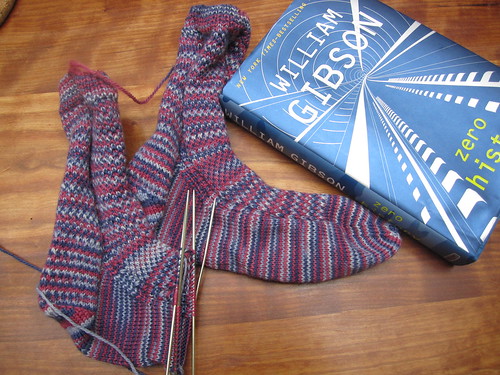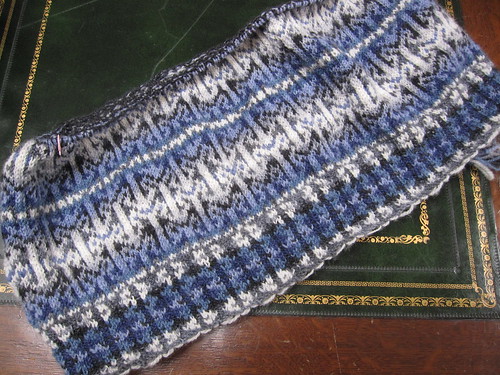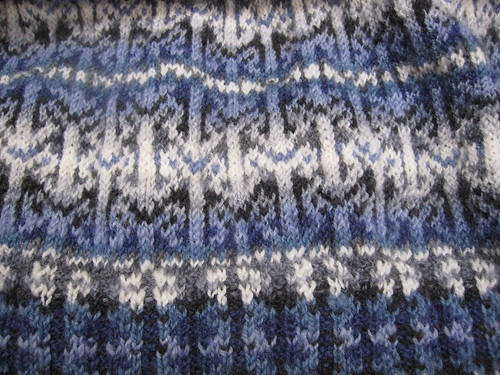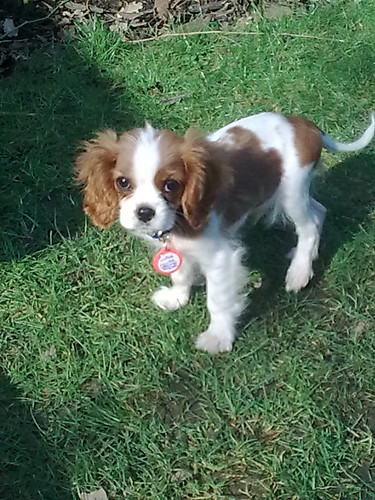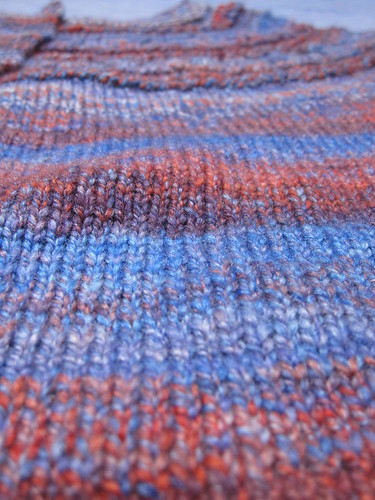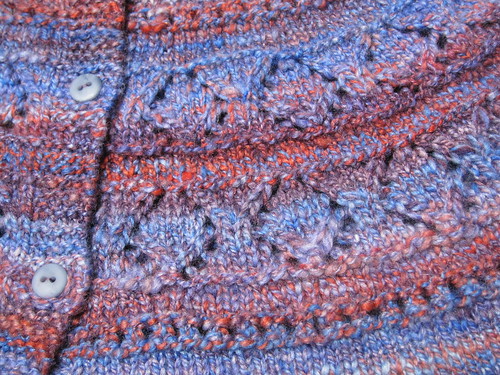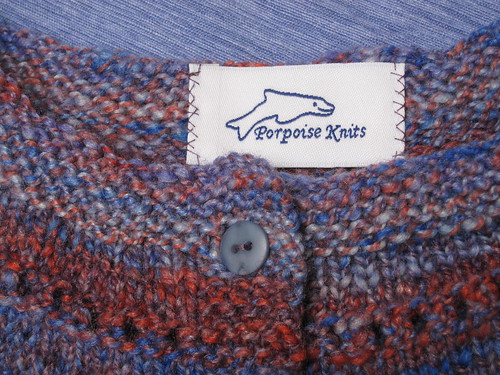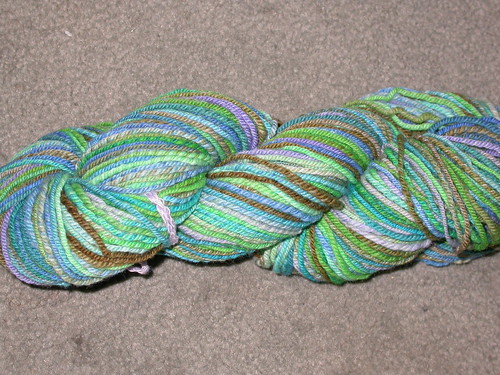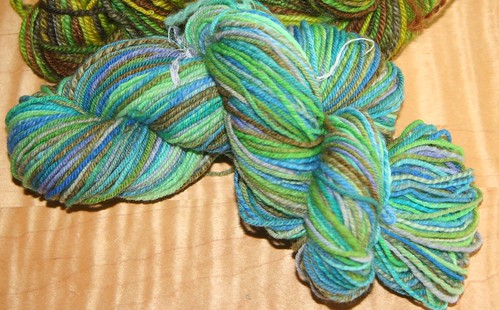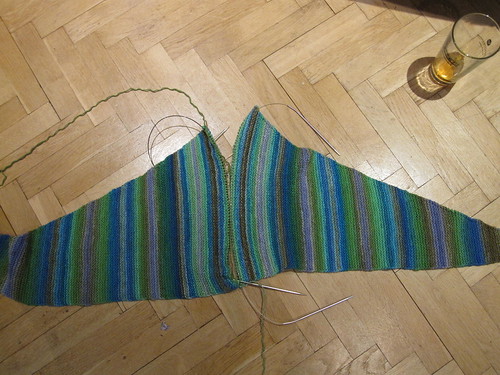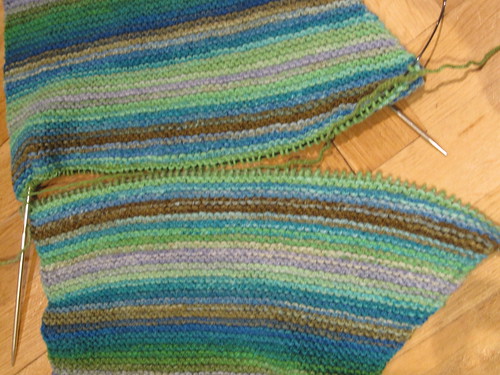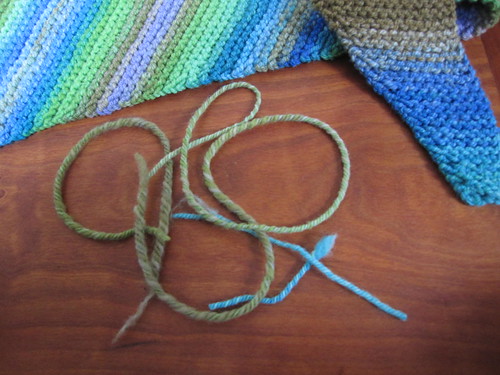Since I have just returned from a trip to the local Royal Mail outlet and sent off three packages to their new homes in the States, I thought I'd talk a bit about how to knit with handspun. Or at least, about how I knit with handspun.
As I see it, there are two scenarios: 1) you are trying to recreate a commercial yarn for a particular pattern, or match a handspun yarn you already have to a particular pattern, and 2) you are taking some handspun and knitting it into something on your own, without a pattern (or using a pattern for which gauge is not so critical and you know you have enough yardage). The second situation is easiest, so let's start with that.
The biggest question I come across is what needle size do I use with handspun? My standard way to choose a needle size to start with is to double the yarn and see which hole it fits through on my needle gauge.

If the yarn is really variable, I might do this with several different sections to make sure I pick a needle size that will work for most of the yarn thickness. I tend to knit fairly true to gauge (i.e. with commercial yarn, if I use the suggested needle size, I usually get very close to the gauge given on the label).
If it's going to be an item where gauge is important (like a sweater), I'll knit a swatch. Sometimes I'll knit the swatch, get a gauge number and then rip back the swatch to use the yarn (I did this for the girls' sweaters last summer), but that can lead to disaster if the yarn changes dramatically when it gets washed and blocked. With my own handspun, I've hopefully gotten any shifting around over with when I finish it, but you never know...
If I'm going to knit something like a hat or a scarf, and gauge isn't so important, then I'll just start knitting. If the fabric is coming out fine, then I'm off. If I don't like it, then I'll rip back and adjust needle sizes. Note: this approach only works if you can frog with abandon, and be honest about what you're getting before you get too much time invested in the project.
The tougher scenario is when you're trying to use a handspun yarn to substitute for a commercial yarn for a particular pattern. The key thing to worry about here is grist. Grist is one of those weird spinning terms that can be really confusing - grist is simply a measure of how many yards (or meters) of yarn you have per unit weight (typically expressed in pounds or kilograms). So a skein of Socks that Rock lightweight has 360 yards in 4.48 ounces - that works out to 1286 yards per pound (ypp). Fairly straightforward, right?
But why is grist important for knitting? Grist helps you determine whether or not your handspun will work as a substitute for a particular commercial yarn. For example, Amy King's Tappan Zee pattern was written for handspun and calls for a DK weight yarn. A lot of people on Ravelry have used Elsbeth Lavold Silky Wool for this pattern - Silky Wool is about 1745 ypp. If you used a bulky handspun that came in at 500 ypp, you'd end up with a sweater that would fit a yeti. Or be bullet proof, if you tried to get the correct gauge.
Similarly, you could use a DK weight handspun, but it might have a grist of 800 ypp - much denser then the ~1300 ypp called for in the pattern. You could knit the sweater with this yarn, to the correct gauge, but it probably wouldn't make a very nice fabric. It would be too thick, too dense, and not have the light, drapey feel of the less dense yarn.
Other things that come in to play besides grist are the yarn composition. If you're trying to substitute a bouncy merino yarn with a similar weight handspun alpaca yarn for a pair of socks, you're going to be disappointed: fibers like alpaca and silk are very inelastic and have no memory. Those socks will be pooling down around your ankles in no time. Similarly, if you are going for a drapey fabric knit from a commercial yarn containing bamboo, a sproingy handspun Targhee yarn is probably not going to do the trick. Generally speaking, it's best to try and match the fiber contents of your yarns - maybe not down to the exact percentages, but try to get as close as possible.
So choosing a handspun yarn as a commercial substitute can be a bit tricky. My biggest recommendation is swatch, swatch, swatch. And then swatch some more. When I knit my TZ, I still used a needle gauge to check that my yarn would work with the suggested needle size. And then I knit a swatch, and discovered that my yarn was waaaaaay overplied and needed to be fixed. Swatching, while a pain in the ass, can save you hours of frustration and months of hiding projects in the bottom of a bag because something is off.
As for me, I've got one finished batch of yarn, and one in progress that I'm trying to match to commercial yarns. The first one has been sitting in the stash for seven months, marinating, and the other is still in progress. Hopefully when they get knit up, I'll have a couple of successful experiments. And if they're not successful, then it's back to the drawing board. That, for me, is part of the fun of doing all this in the first place!
